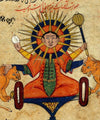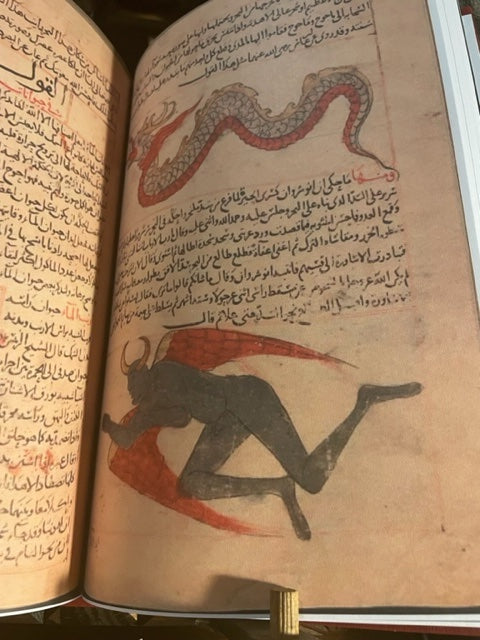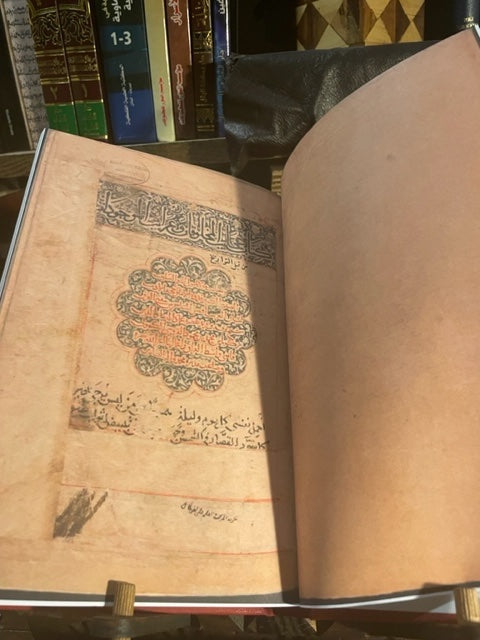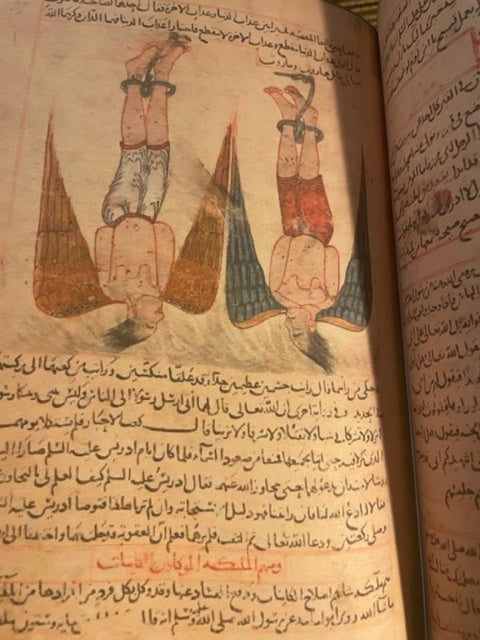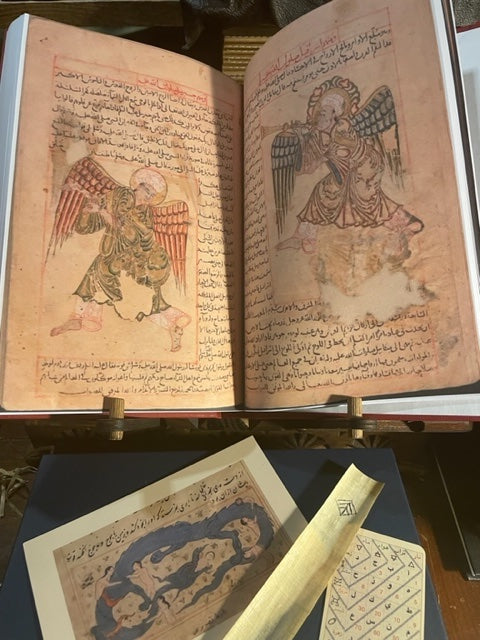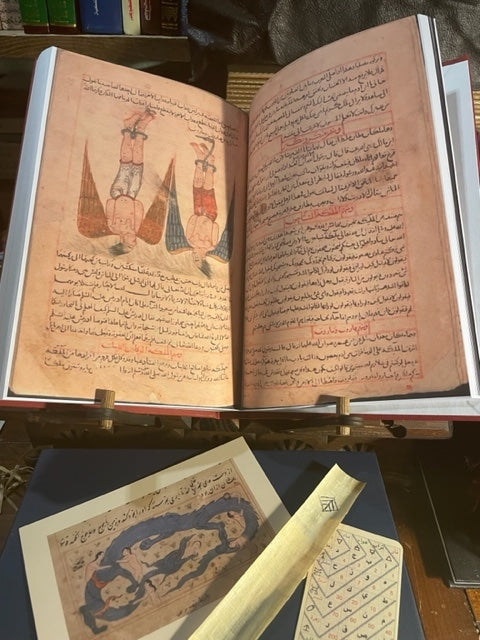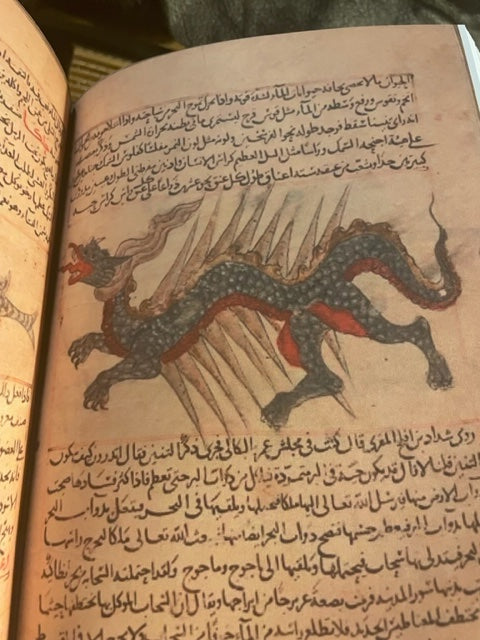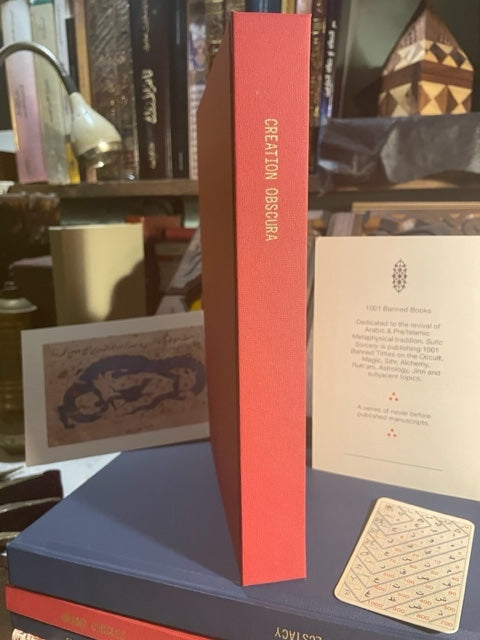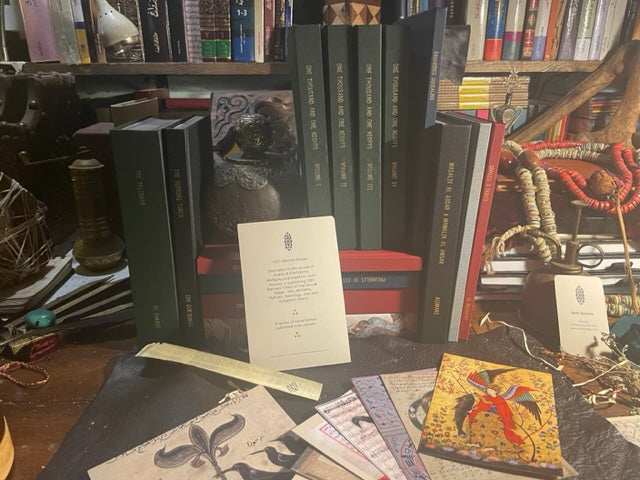Sufic Sorcery
Creation Obscura عجايب المخلوقات وغرائب الموجودات
Couldn't load pickup availability
A Faithful reproduction of the Original Arabic Manuscript. Some manuscripts may have blur, missing pages or black spots. one copy available.
Red Linen wrap Hardcover with gold spine embossing, colored and fully illustrated 430 pages rare Arabic manuscript: عجائب المخلوقات or a better suited translation of this tittle 'Creation Obscura'.
من الكتب الهامة في الصنعة
عجائب المخلوقات وغرائب الموجودات كتاب من تأليف العالم والجغرافي أبو عبد الله بن زكريا القزويني.[1] يتناول هذا الكتاب علم أوصاف الكونمن وصف السماء وما فيها من كواكب وأبراج وحركاتها وما ينتج عن ذلك من فصول السنة، وتكلم عن الأرض وتضاريسها، والهواء وما فيه من رياح وأنواعها، والماء والبحار، والجزر، وأحيائها وتكلم عن النبات والحيوان التي تسكن اليابس ورتبهم أبجدياً. ويلاحظ القارئ البراعة في العرض، ودقة الملاحظة، والاستنتاج السليم، والكتاب به أربع مقدمات، ثم قسمه إلى مقالات كل مقالة بها عدة فصول. وخالف القزويني من تقدمه من علماء العرب في عدم ذكر الأشعار التي تصف النبات أو الحيوان بكثرة فكانت دراساته علمية بحتة وليست أدبية.
'Aja'ib al-Makhluqat wa Ghara'ib al-Mawjudat, (Arabic: عجائب المخلوقات وغرائب الموجودات, meaning The Wonders of Creatures and the Marvels of Creation) is an important work of cosmography by Zakariya al-Qazwini, who was born in Qazwin (Iran) in the year 600 AH/1203 AD.
detailing the inhabitants of the seven heavenly spheres as well as the dwellers of the seven Under Earths just bellow our feet
Framework
Qazwini's cosmography consists of two parts, the first part is celestial, dealing with the spheres of the heaven with its inhabitants (the angels) and chronology. Astronomical knowledge of that time is compiled together with astrological ideas.[1]
The second part discusses the terrestrial: the four elements, the seven climes, seas and rivers, a sort of bestiary on the animal kingdom (including mankind and the jinns), the plants, and minerals.[1] He discusses her man and the faculties of his soul, his character, weaknesses and illnesses.
Also, the cosmography of Ahmad al-Tusi (Aḥmad al-Ṭūsī[a]) is very similar and bears the same title;[3]though the latter characterized by the concept of the unity of God and the unity of creation.[citation needed].
Celestial cosmography
Qazwini tells that the earth was swinging in all directions, until God created an angel to bear it on his shoulders and steady it with his hands. A green Jacinth slab was placed underneath the angel, the slab borne by a gigantic bull Kuyūthā,[b] which in turn rested on the great swimming fish Bahamūt.[4][5][6][c]
Qazwini's cosmography above have been compared to a similar entry in Yaqut's Mu'jam al-Buldan[10] and Ibn al-Wardī's Kharīdat al-'Ajā'ib, with small differences noted.[4]
Time
When discussing time, Qazwini makes parallel comparison of the Islamic, Roman and Iranian calendars. Thus he links the days of the week to the sacred history of Judaism, Christianity, and Islam, e.g. the holy days Friday (Islamic day of congregational prayer/salah), Saturday (Jewish sabbath) and Sunday (Christian day of rest) and how they came to be regarded as holy. The days are also linked to lawful and unlawful things and acts.[citation needed]
Angelology

Qazwini shows that God created many things that are unknown to the people (Quran 16:8), and a fundamental part of this, with central importance, is God's Throne, His footstool are the angels and the jinn (demons, evil/good spirits).[d]
The celestial spheres are inhabited by the angels. The angels are good perfect beings without negative feelings or passion, they are obedient and most importantly, they keep the order of the creation and govern everything on earth; the jinn and devils are bad and imperfect creatures who possess passion and wrath and are disobedient. Qazwini's work contains moreover angelology that has roots partly in the Quran and hadith.
There are two types of angels in the Quran, the one being the guards of hell (96:18) and angels that nearest to God (4:170, 83:21). Qazwini also mentions the angels who carry the Throne of God (the idea goes back to the Jahiliyya): they are four in number in the form of a man, bull, eagle and lion. On the Day of Resurrection the Throne will be carried by “eight” (Quran 69:17), and this traditionally refers to eight angels. Next to these is the angel ar-Ruh or the Spirit, who is actually first in order and the greatest. His breath quickens the creatures and he knows the order of the spheres, planets, elements, minerals etc. He is the one who decides the movement and stillness of things by the will of God. This angel is followed by Israfil; he transmits the orders of God and blows the horn. He is not mentioned in the Quran but in hadith and linked to the Day of Resurrection. Israfil carries the “tablet” (lawh) and the “pen” (qalam). Whether the abovementioned angels or Gabriel, Michael or others all of them have a role in keeping the order of the creation. It is also believed that angels have about seventy wings each.
Then God sent angels who inhabited the earth. One sent in exile was young Azazil whom the angels educated. He acquired their knowledge and became like them and even their leader. But he fell into disgrace because he disobeyed God to prostrate himself before Adam as the vicegerent of God on earth. Azazil goes back to Judaism and is mentioned in the Quran (2:32 etc.) as Iblis, the jinni. In Volksislam it is believed that Iblis is present in baths, bazaars, crossroads, intoxicating drinks, and is associated with flutes, poetry, tattoos, lies and illnesses.
God also persecuted and imprisoned many of the jinn and exiled them. Jin and ghuls are then considered terrestrial beings, occupying and a place between animals and mankind, and discussed in the second part of Al-qazwini's work.[1]
Terrestrial cosmography
The earth, being part of the lower spheres, brings forth minerals, plants and living creatures such as animals and man. In Qazwini's classification there are seven types of living creatures – man, jinn, animals used for riding, animals that graze, beasts, birds and insects – and creatures that look strange or are hybrids.
Man
Man has the highest rank in the order of God's creation (macrocosm): he is its quintessence (microcosm) and can be both the embodiment of the angels and Satan. Man with his rational soul has the capacity to think and talk and the choice to ascend to the highest or lowest stations in life. Man's soul is immortal and he is created for immortality; he changes his place of living from the womb to the earth, and from there to paradise or hellfire(Quran 20:57).
Next to man are the jinn who were created from smokeless fire and can be in different forms. It is also believed that the jinn represent the rebellious among men or that angels were created from the light of the fire and the devils or jinn from its smoke. According to a legend the jinn were created before Adam and lived on the land, sea, plains and mountains and that God's mercy for them was boundless. They had a government, prophets, religion and laws but they became disobedient and stubborn and broke the rules of the prophets which culminated in chaos on earth. Solomon became their lord whom they obeyed.[e]
Bestiary
God created the birds because He knew that many people would deny the existence of flying creatures, especially the angels. Furthermore, Qazwini adds as proofs that God created birds with three wings, as He did the unicorn, the Indian ass with a horn or the bat without wings; why not angels? Among the birds Qazwini classifies the Anqa or Simurgh (Phoenix) as the most known bird and the kin of birds that lived alone on Mount Qaf. This idea goes as back as to the time of Zoroaster. In more recent traditions the Anqa is a wise bird with experience gained throughout many ages and gives admonitions and moral advice.
Long before Adam was created, this bird lived without procreation; he was single and the first and most powerful bird. The “golden age” of the Simurgh was the time of Solomon in which not only ministers were near his throne but also animals and birds with whom Solomon could speak; the Anqa also talked to him and was the most respected. The second bird that is also recurring in classical Persian literature and mentioned by Qazwini is the Homa (paradise bird). When it lands on someone's head, that person becomes the king of his land. Being also a bird used in Iranian mystical symbolism is the salamander or “fire bird”, which was not seen since the time of Muhammad. Qazwini talks about the hoopoe (hudhud) that has a central role in Iranian mysticism too, only in passing; here it is described as being able to see water from afar but not the mesh that is in front of its eyes.
So the hoopoe symbolizes fate: when it comes, the eyes of man are blinded, i.e. man is not able to predict his fate. Another exceptional bird in Qazwini's list is the eagle because lions feared it and from his wings fire appears. Birds that were conceived as strange hybrids by Qazwini are the vulture, having the claws of the rooster, or the ostrich with the feet of a camel and the body of a bird; this bird eats stones and flames and can live in fire for ten years. He is also able to digest legs of a horse and birds but not date pits. The ostrich fears his own shadow and always walks against the sun. There are also other rare and strange birds, for example a big bird in Khuzistan that attacks camels and elephants and has eggs similar to crystal; the “purple bird”, a white bird that sits on a rock in the Chinese Sea and the person that looks at that rock must laugh to death, except that this bird lands on the rock; or a bird in Tabaristan which is seen in spring and carries one hundred sparrows on its tail and eats one each day.
Materials
Materials
Dimensions
Dimensions
Care information
Care information
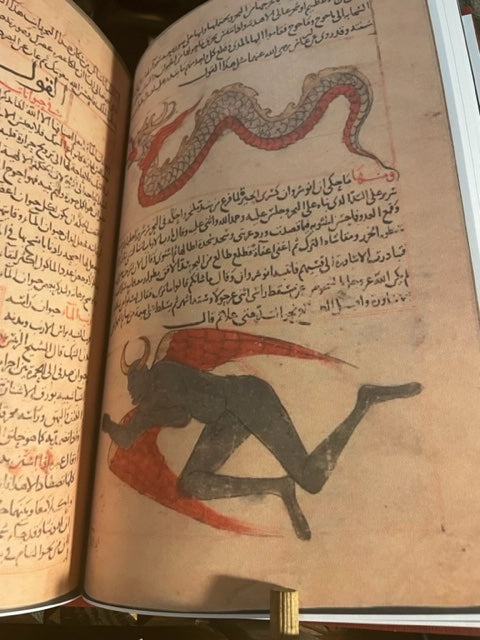
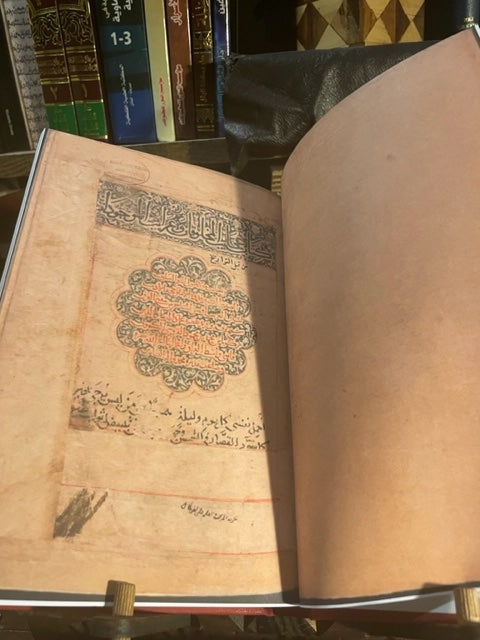
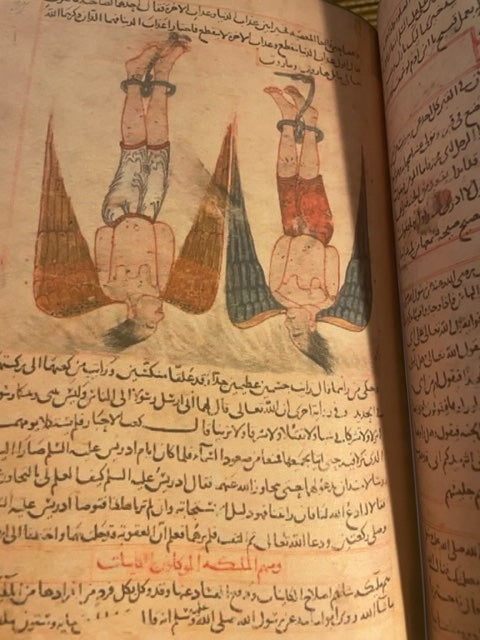
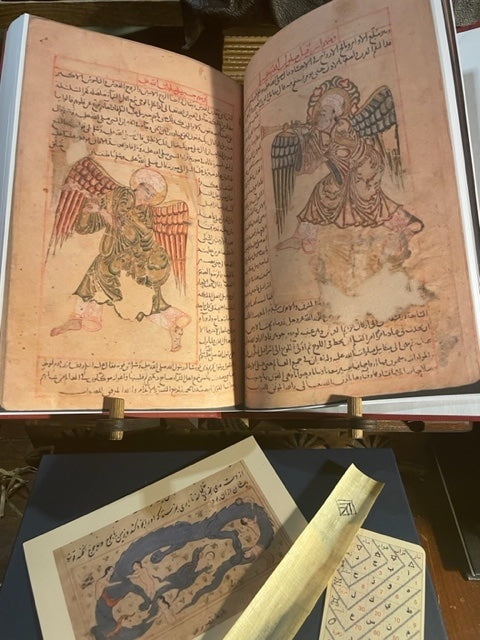
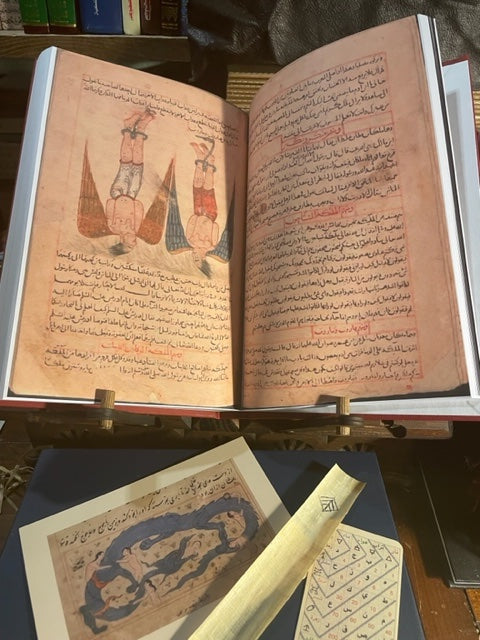
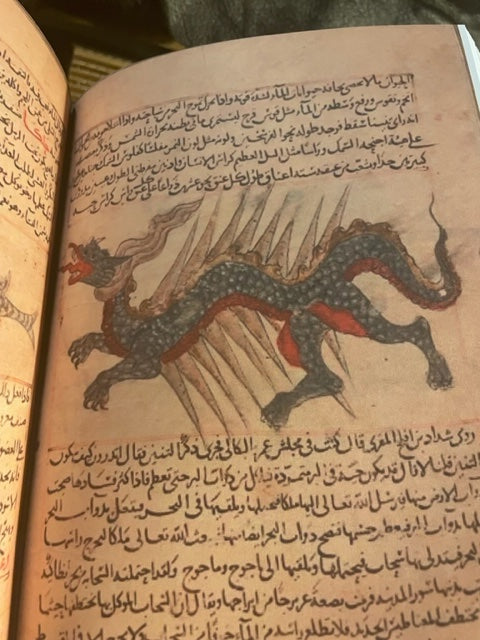
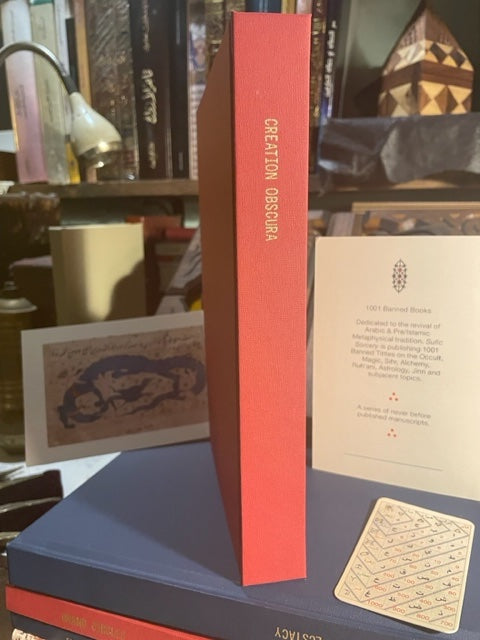
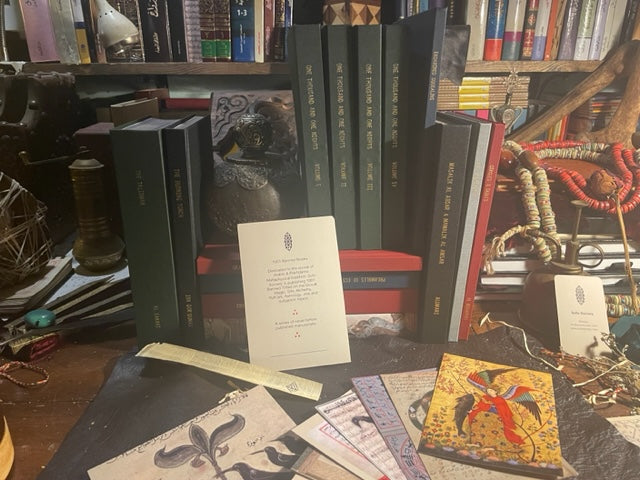
Image with text
Pair text with an image to focus on your chosen product, collection, or blog post. Add details on availability, style, or even provide a review.
